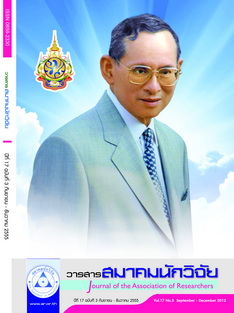PERSPECTIVES AND APPROACH TO DRUG PROBLEM BY MUSLIM WAY
Main Article Content
Abstract
The research study aims at investigating the existing Muslim-based perspectives and ways to cope with the drug problems, which are considered very critical in Thailand. Concepts and theories on community justice were employed and description on Muslim contexts was given. As a qualitative study, in-depth interviews and document analysis were conducted, with emphasis on descriptive findings.
The findings posit that the process of community justice contributed to drug problems in four aspects, including (1) prevention and control on crimes and wrongdoings, (2) conflict management through reconciliation, (3) remedy and reinforcement, and (4) return of the culprits to the community. Also, the Muslim justice process was found to have proper elements contributing to the following areas: (1) community consensus called “Hukum Pakat,” (2) community conflict prevention called “Hibada,” (3) community reconciliation justice called “ Musawah,” (4) community remedy and rehabilitation for the culprits known as “Tawbah,” and (5) community return of decent citizens, as the completion stage of the community justice.
The so-called Thoraneekum Community (pseudonym) was reported to adopt and apply the Muslim-based community justice process so successfully and satisfactorily that it was entitled a drug-free community or “white community” by the Thai Metropolitan Police Division 3. Thus, the Muslim-based community justice has played a vital role in coping with drug problems.
Article Details
บทความที่ปรากฏในวารสารนี้ เป็นความรับผิดชอบของผู้เขียน ซึ่งสมาคมนักวิจัยไม่จำเป็นต้องเห็นด้วยเสมอไป การนำเสนอผลงานวิจัยและบทความในวารสารนี้ไปเผยแพร่สามารถกระทำได้ โดยระบุแหล่งอ้างอิงจาก "วารสารสมาคมนักวิจัย"
References
กิตติพงษ์ กิตยารักษ์. (2545). กระบวนการยุติธรรมเชิงสมานฉันท์: ทางเลือกใหม่สําหรับกระบวนการยุติธรรมไทย กรุงเทพฯ : สํานักงานกองทุนสนับสนุนการวิจัย
คณะรัฐมนตรี. (2554). คําแถลงนโยบายของคณะรัฐมนตรี. ค้นเมื่อ 30 กันยายน 2554, จาก http://www.cabinet .thaigov.go.th/bb_main31.htm.
จุฑารัตน์ เอื้ออํานวย สุทธิ สุขยิ่ง และ มูฮัมหมัดรอฟีอี มูซอ. (2551). ยุติธรรมชุมชน: การเปิดพื้นที่ของชุมชนในการ อํานวยความยุติธรรม (Community justice: widening the sphere of communities in doing justice), กรุงเทพฯ : สํานักงานกองทุนสนับสนุนการวิจัย (สกว.).
ชัยวัฒน์ ปานบุญทอง. (2541). คุณภาพชีวิตด้านชีวิตครอบครัวและชุมชนของชาวไทยมุสลิมในชุมชนชนบท : ศึกษาเฉพาะกรณีบ้านตันหยง ตําบลบาตง อําเภอรือเสาะ จังหวัดนราธิวาส. ภาคนิพนธ์คณะพัฒนาสังคม,
สถาบันบัณฑิตพัฒนบริหารศาสตร์, กรุงเทพฯ
มูฮัมหมัดรอฟีอี มูซอ (ม.ป.ป.). การจัดการความขัดแย้งในวิถีมุสลิมไทย.ปัตตานี, มหาวิทยาลัยสงขลานครินทร์ วิทยาเขตปัตตานี วิกิพีเดีย. (2554). ยาเสพติด. ค้นเมื่อ 30 กันยายน, 2554, จาก http://th.wikipedia.org/wiki/
สถานีตํารวจนครบาลลําผักชี. (2554). สถิติอาชญากรรม. กรุงเทพฯ : สํานักงานตํารวจแห่งชาติ สมชาติ เอี่ยมอนุพงษ์. (ม.ป.ป.). ยุติธรรมชุมชนคืออะไร. กรุงเทพฯ: กรมคุมประพฤติ กระทรวงยุติธรรม สมาน ดือราแม. (2545). ภูมิหลังและบทบาทของคณะกรรมการมัสยิดในการพัฒนาชุมชน: ศึกษาเฉพาะกรณีมัสยิด
ในอําเภอสิงหนคร ภาคนิพนธ์คณะพัฒนาสังคม, สถาบันบัณฑิตพัฒนบริหารศาสตร์, กรุงเทพฯ
สุเทพ สุวีรางกูร. (2551). ปัญหาสังคม. กรุงเทพฯ: โอเดียนสโตร์,
สุพจน์ แสงเงิน. (2547). มิติทางวัฒนธรรมที่เอื้อต่อความเข้มแข็งของชุมชนแผ่นดินทองคอยรุตตก-ตักวา กรุงเทพฯ สํานักงานคณะกรรมการวัฒนธรรมแห่งชาติ กระทรวงวัฒนธรรมการ
อดุลย์ วังศรีคูณ. (2543). การสังเคราะห์งานวิจัยเกี่ยวกับกระบวนการเรียนรู้ของชุมชนที่ทําให้ชุมชนเข้มแข็ง: การ วิจัยเชิงชาติพันธุ์วรรณาอภิมาณ. จุฬาลงกรณ์มหาวิทยาลัย,
อริศราวรรณ สมีดี. (2551). บทบาทของคณะกรรมการศูนย์ยุติธรรมชุมชนในการไกล่เกลี่ยข้อพิพาทโดยสันติวิธี มหาวิทยาลัยขอนแก่น
อังคณา บุญสิทธิ์. (2551). ยุติธรรมชุมชนกับความสมานฉันท์ในสังคมไทย. กรุงเทพฯ: กรมคุมประพฤติ กระทรวงยุติธรรม
Karp, D. R., & Clear, T. R. (2000). Community justice: A conceptual framework. Boundaries changes in criminal justice organizations, 2, 323-368.


